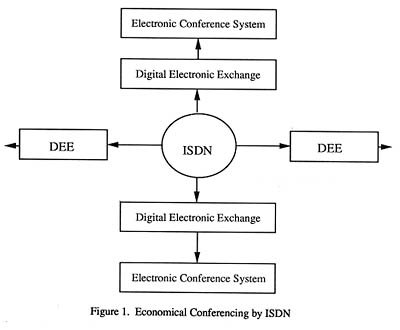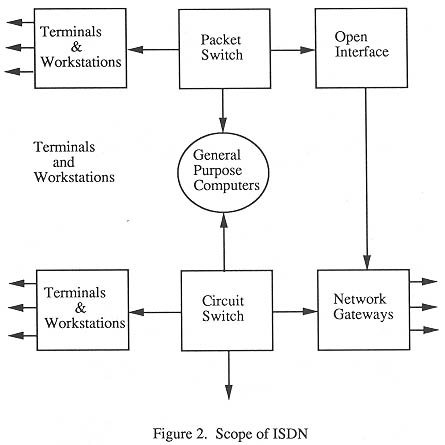
C. C. Parmar, Ajit J. Shah and Akhilesh Arora
Faculty of Technology and Engineering
M.S. University of Baroda Baroda
Baroda 390001
Keywords : ISDN, Information Systems Architecture, Circuit Switching, Packet Switching, LANs, Integrated Services Digital Network, see ISDNl. INTRODUCTIONAbstract : An information system architecture defines a structure for describing communications connectivity between users of information and sources of information. Standards now being defined for the integrated services digital network (ISDN) plays on important role in the architecture. The support of ISDN with the Information System Architecture promises to provide the users
with compatibility and high functionality. This paper gives an overview of what an Information System Architecture is, the elementary concepts of the ISDN, and the role of ISDN in the Information System Architecture. It is also hoped that this paper can clarify the concepts of ISDN so that a user can have a basis for evaluating ISDN as a potential resource.
Users have driven the information movement and management industry to provide greater flexibility, control, responsiveness and integrative capability in communication products and services. Technology has provided the tools of digital, software driven distributed processing. One component of the response to the users by the industry has been the concept of ISDN (Integrated Services Digital Network).
The ISDN is defined by CCITT as an end digital network that supports
a wide range of services accessed by a limited set of multipurpose user
network interfaces. It is a technology that integrates digitized voice
and data, not only computer data but other digital information as well
such as fax and video. ISDN transmits data as digital signals in far greater
volumes than traditional analog networks. It can also provide an economical
and flexible electronic conferencing network with a low running cost for
international communications (Fig.1).

2. INFORMATION SYSTEM ARCHITECTURE
Information Systems Architecture is an overall architectural plan for compatibility. The ISDN provides an answer to many of the lower layer equipment compatibility problems in the integrated voice and data environment. Therefore both ISDN and Information Systems Architecture are important to the users preparing to procure new systems.
A systems architecture defines a structure for describing communications connectivity between users of information and sources of information. The architecture identifies the services to be provided and categorizes or structures them in an orderly way. To achieve communications and to provide services, it describes the rules, procedures and formats. The integration of voice and data, the integration of premises capabilities with the network services and information systems management are major aspects of the Information Systems Architecture. International Standards play an important role in achieving this compatibility.
3. SCOPE
The scope of the Information Systems Architecture is shown in Fig. 2. Spread throughout the users building are the workstations of various types such as telephones, terminals, modems and image devices. Premises distribution takes the information from throughout the building and brings it to centralized location where switches might be found. This distribution must be capable of supporting needs ranging from low bit rate telemetry to video.

4. STRUCTURE
An Information Systems Architecture should make use of the layering concepts and service categories presented in the International Organization for Standardization (ISO) model of pen Systems Interconnection (OSI). It should be based on this model because the language and concepts already exist and are well known, and because it facilitates the introduction of international standard protocols. The OSI model is computer oriented. ISDN introduces the concepts of integration of voice and data. Information Systems Architecture integrates voice into the model by recognizing that there are differences in protocol needs for voice and data, but there are also advantages to bringing them together conceptually at particular layers. Conceptualizing the integration of voice and data allows for planning of services such as speech annotated text and dialing from directories. The integration of voice and data in the architecture also allowed for common altering and retrieval by the recipient, again using many different voice, data and image devices.
5. ROLE OF ISDN
Once the structure of the architecture model is decided, specific protocols and interfaces must be identified as well as the rules that must be followed to achieve compatibility. International standard protocols are arrived at in open forum and hence are a solution that can be supported by many companies. The international standard protocols at all layers of the model play a key role in determining the future direction of Information Systems Architecture.
The ISDN standards in particular represent a major step in reaching agreement on the integration of voice and data in the lower layers of the model. The small set of standard interfaces being defined for ISDN will provide lower layer compatibility. The support of the ISDN interfaces and protocols is, therefore, an important part of the Information Systems Architecture lower layer protocol plan
5.1. Integrated Services Digital Network - Most of the effort expanded to date in defining and understanding ISDN has been by service providers and equipment vendors. However in order to be successful, it must satisfy the user's needs. In user's terms the primary attributes of interest are functionality and cost.
5.2. Functionality
Information used by users takes many forms that involve voice, data and control. Messages may be left by talking directly to the recipient, pushing a button on a telephone, talking with a message center attendant, via voice mail or by electric mail. The functionality which will be provided by ISDN is limited only by the imagination of the customers and service providers.
With the ISDN standard interface, a user has integrated access to simultaneous voice and data, services for all telecommunications needs, flexibility for selecting and reconfiguring services as needs grow. Also by eliminating the need for multiple, services associated interface for todays multiple services, ISDN integrated access reduces the overall cost of services. Furthermore no additional wiring in buildings is needed to provide multiple services over the standard open interface.
In the near term, ISDN functionality is based on digital connectivity, enhanced services, and integration. Users will have far greater data throughput than is available is existing analog arrangements, without the added expense of modems. This high speed connectivity will significantly enhance the data exchange required for applications such as graphics, Computer Aided Design and document interchange.
A potential service that will be offered by ISDN is "User to user information capability" that could convey certain transaction information for example - Library Card No. - to a called database or computer system. The ISDN standards have been developed so as to achieve very high speed and flexibility.
ISDN also promises the benefits associated with voice and data integration. In the ISDN model a single interface provides access to both the voice and data communications. The voice and data connections are controlled by a single signalling channel. This integration can provide enhanced capabilities such as phone management, directory services and integrated messaging. The integration provided by ISDN also simplifies building operations. The single voice/data interface simplifies building wiring by using two twisted pairs to provide all voice and data needs. It also reduces the physical space required for equipment and cuts down on the maze of wire that is all too often under a knowledge worker's desk.
5.3. Cost
In addition to providing increased functionality, ISDN must reduce user's overall cost. ISDN promises to improve cost from several perspectives.
The first and most obvious cost improvement comes from the support of standard interfaces. If a majority of switch and terminal vendors support the standard interface, the production volumes of VLSI required to implement the interfaces will be substantial. The large volumes should result in reduced costs for devices and a corresponding reduction in equipment costs.
Another aspect is the ability to provide all voice and data communications over two twisted pairs and so it should greatly reduce building wiring costs. This cost reduction will come primarily from the elimination of separate distribution plans for voice and data, such as twisted pair wiring plus Coax.
A real, but even more difficult to quantify, cost benefit of ISDN is improvement in the efficiency of the work force. High speed data access, phone management and directory services, improved messaging and cross network feature transparency should all make a knowledge worker more efficient and reduces the user's overall cost of use.
6. CONCLUSION
ISDN is an " enabling technology" think of it as a highway that enables
new cities to spring up. It is more than just a new switch or even a new
network; It is a potential revolutionary force for the role of technology
in society. It is hence hoped that the support of ISDN will provide customers
with standard access to enhanced capabilities, which are based on integrated
voice and data and digital connectivity.
REFERENCES
l. Neigh, James L., & Leslie A. Spindel, "Role of ISDN in AT&T Information Systems Architecture," AT&T Journal, January 1986, pp. 45-54.
2. Kumar, K. Madhu, "Integrated Services Digital Network," Electronics For You, August 1988, pp. 47-49.
3. Aldermeshian, Hrair, "ISDN Standards Evolution," AT&T Technical Journal, February 1986, pp. 19-20.
4. Duncanson,Jay and Joe Chew, "The Ultimate Link," Byte, July 1988, p. 278.
5. Roca, Richard T., "ISDN Architecture," AT&T Technical Journal, Jan. - Feb. 1986, p. 6.
6. Carney, David L., & Edward M. Prell, "Planning For ISDN in the Sess Switch," AT&T Technical Journal, p.36.
7. Highdon, Marda L., Judith T. Page & Peter H. Stunteback, "AT&T Communication - ISDN Architecture," AT&T Technical Journal, Jan. - Feb. 1986, p. 32.
8. "A New Breed Evolves with ISDN," OEP, Sept. 1988, p. 66.
9. "New Age of Communications-ISDN," The Wheel Extended, 18 (2): 31-32
(1988).